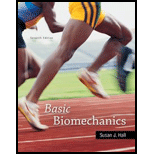
Basic Biomechanics
7th Edition
ISBN: 9780073522760
Author: Susan J Hall
Publisher: McGraw-Hill Education
expand_more
expand_more
format_list_bulleted
Concept explainers
Textbook Question
Chapter 6, Problem 5AP
If the fibers of a pennate muscle are oriented at a 45° angle to a central tendon, how much tension is produced in the tendon when the muscle fibers contract with 150 N of force? (Answer: 106 N)
Expert Solution & Answer
Want to see the full answer?
Check out a sample textbook solution
Knowledge Booster
Learn more about
Need a deep-dive on the concept behind this application? Look no further. Learn more about this topic, bioengineering and related others by exploring similar questions and additional content below.Similar questions
- What is the function of the sarcoplasmic reticulum in muscle cell contraction?arrow_forwardFigure 38.37 Which of the following statements about muscle contraction is true? The power stroke occurs when ATP is hydrolyzed to ADP and phosphate. The power stroke occurs when ADP and phosphate dissociate from the myosin head. The power stroke occurs when ADP and phosphate dissociate from the actin active site. The power stroke occurs when Ca2+ binds the calcium head.arrow_forwardIn the diagram below, label the fine structure of a muscle, down to one of its myofibrils. Identify the basic unit of contraction in a myofibril.arrow_forward
- What are the structural and functional differences between slow and fast muscle?arrow_forwardWhich arrangement best describes a bipennate muscle? The muscle fibers feed in on an angle to a long tendon from both sides. The muscle fibers feed in on an angle to a long tendon horn all directions. The muscle fibers feed in on an angle to a long tendon horn one side. The muscle fibers on one side of a tendon feed into it at a certain angle and muscle fibers on the other side of the tendon feed into it at the opposite angle.arrow_forwardA muscle that has a pattern of fascicles running along the long axis of the muscle has which of the following fascicle arrangements? circular pennate parallel rectusarrow_forward
- You are training athletes for the 100-meter dash. They need muscles specialized for speed and strength, not endurance. What muscle characteristics would your training regimen aim to develop? How would you alter it to train a long-distance swimmer?arrow_forwardThe _____ is the basic unit of muscle contraction. a. myofibril b. sarcomere c. muscle fiber d. myosin filamentarrow_forward
arrow_back_ios
arrow_forward_ios
Recommended textbooks for you
 Human Physiology: From Cells to Systems (MindTap ...BiologyISBN:9781285866932Author:Lauralee SherwoodPublisher:Cengage LearningLifetime Physical Fitness & WellnessHealth & NutritionISBN:9781337677509Author:HOEGERPublisher:Cengage
Human Physiology: From Cells to Systems (MindTap ...BiologyISBN:9781285866932Author:Lauralee SherwoodPublisher:Cengage LearningLifetime Physical Fitness & WellnessHealth & NutritionISBN:9781337677509Author:HOEGERPublisher:Cengage Human Biology (MindTap Course List)BiologyISBN:9781305112100Author:Cecie Starr, Beverly McMillanPublisher:Cengage Learning
Human Biology (MindTap Course List)BiologyISBN:9781305112100Author:Cecie Starr, Beverly McMillanPublisher:Cengage Learning Biology 2eBiologyISBN:9781947172517Author:Matthew Douglas, Jung Choi, Mary Ann ClarkPublisher:OpenStax
Biology 2eBiologyISBN:9781947172517Author:Matthew Douglas, Jung Choi, Mary Ann ClarkPublisher:OpenStax

Human Physiology: From Cells to Systems (MindTap ...
Biology
ISBN:9781285866932
Author:Lauralee Sherwood
Publisher:Cengage Learning

Lifetime Physical Fitness & Wellness
Health & Nutrition
ISBN:9781337677509
Author:HOEGER
Publisher:Cengage

Human Biology (MindTap Course List)
Biology
ISBN:9781305112100
Author:Cecie Starr, Beverly McMillan
Publisher:Cengage Learning

Biology 2e
Biology
ISBN:9781947172517
Author:Matthew Douglas, Jung Choi, Mary Ann Clark
Publisher:OpenStax


Phylogenetic Mysteries: Crash Course Zoology #12; Author: CrashCourse;https://www.youtube.com/watch?v=cVaw7nF72Aw;License: Standard youtube license